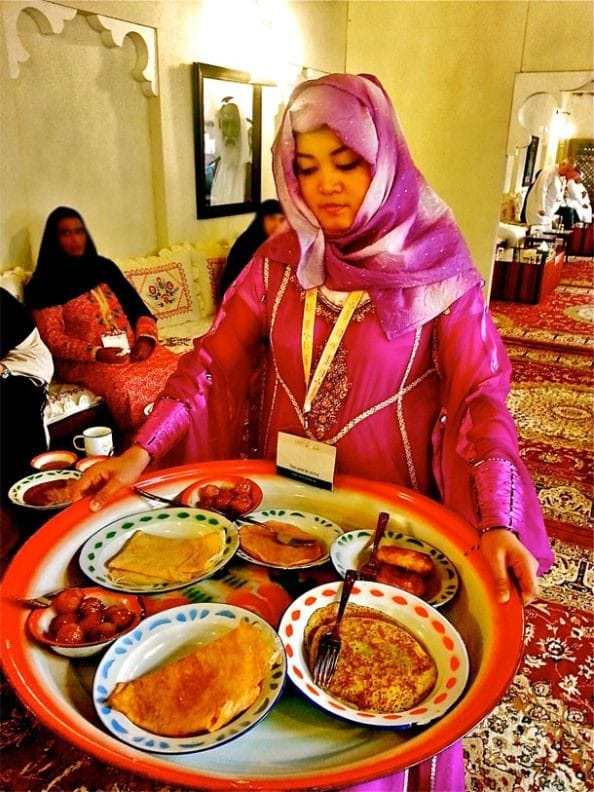Blending Flavors: The Fusion of Indian and Middle Eastern Cuisine in UAE’s Food Scene
The UAE is a melting pot of cultures, and this is evident in its food. Indian and Middle Eastern cuisine has a significant influence on the food in the UAE, creating a unique fusion that is delicious and diverse.
Middle Eastern cuisine has a long history and is known for its exotic spices, herbs, and flavors. Some of the most popular dishes in the UAE are borrowed from Middle Eastern cuisine, such as hummus, tabbouleh, and shawarma. The Bedouin cuisine, which is the traditional cuisine of the Arab nomads, has also had a significant influence on Emirati cuisine. The Emirati cuisine is a fusion of Arab, Persian, and Indian flavors, and it has evolved over time to incorporate new ingredients and cooking methods.
Indian cuisine is also an essential part of the UAE food culture. The UAE is home to a large Indian expat community, and this has contributed to the popularity of Indian cuisine in the country. Indian food is known for its rich spices, herbs, and flavors. Some of the most popular Indian dishes in the UAE are biryani, butter chicken, and tandoori chicken. Indian sweets, such as gulab jamun, rasgulla, and jalebi, are also popular in the UAE.
The influence of Indian and Middle Eastern cuisine on food in the UAE can be seen in the way dishes are prepared and served. One of the most noticeable aspects of Middle Eastern cuisine is the use of spices, which are used to add flavor and depth to dishes. The spices used in Middle Eastern cuisine include cumin, coriander, turmeric, cinnamon, and cardamom. These spices are also used in Indian cuisine, and they are known for their health benefits as well.
Another way in which Indian and Middle Eastern cuisine have influenced food in the UAE is through the use of bread. In Middle Eastern cuisine, bread is a staple food, and it is served with every meal. Pita bread is the most common type of bread used in Middle Eastern cuisine. Indian cuisine also has a rich history of bread making, and naan, roti, and paratha are some of the most popular breads in Indian cuisine. In the UAE, these breads are served with curries and other dishes.
One of the most significant contributions of Indian and Middle Eastern cuisine to food in the UAE is the concept of mezze. Mezze is a style of eating that involves sharing small plates of food, and it is common in Middle Eastern cuisine. In the UAE, mezze is a popular way to eat, and it is often served with hummus, baba ghanoush, and tabbouleh.
The influence of Indian and Middle Eastern cuisine on food in the UAE has also led to the creation of new dishes. For example, the Emirati dish called machboos is a fusion of Indian and Middle Eastern flavors. It is made with rice, meat (usually chicken or lamb), and a variety of spices, including saffron, turmeric, and cinnamon. The dish is often served with a side of vegetables and a spicy tomato sauce.
In conclusion, the influence of Indian and Middle Eastern cuisine on food in the UAE is significant. These cuisines have contributed to the diverse and delicious food culture in the UAE, and they continue to shape the way food is prepared and served in the country. From spices and bread to mezze and new fusion dishes, the influence of Indian and Middle Eastern cuisine on food in the UAE is undeniable.





纸飞机下载
… [Trackback]
[…] Read More Information here to that Topic: ceoweeklyuae.com/blending-flavors-the-fusion-of-indian-and-middle-eastern-cuisine-in-uaes-food-scene/ […]
December 24, 2024BACU2025
… [Trackback]
[…] Here you will find 62671 more Information on that Topic: ceoweeklyuae.com/blending-flavors-the-fusion-of-indian-and-middle-eastern-cuisine-in-uaes-food-scene/ […]
January 2, 2025Credit repair
… [Trackback]
[…] Here you will find 63388 additional Info to that Topic: ceoweeklyuae.com/blending-flavors-the-fusion-of-indian-and-middle-eastern-cuisine-in-uaes-food-scene/ […]
January 5, 2025pgslot
… [Trackback]
[…] Info on that Topic: ceoweeklyuae.com/blending-flavors-the-fusion-of-indian-and-middle-eastern-cuisine-in-uaes-food-scene/ […]
January 5, 2025altogel
… [Trackback]
[…] Here you can find 8065 additional Info to that Topic: ceoweeklyuae.com/blending-flavors-the-fusion-of-indian-and-middle-eastern-cuisine-in-uaes-food-scene/ […]
January 23, 2025ซ่อมโปรเจคเตอร์
… [Trackback]
[…] Find More Info here to that Topic: ceoweeklyuae.com/blending-flavors-the-fusion-of-indian-and-middle-eastern-cuisine-in-uaes-food-scene/ […]
January 25, 2025ไฟสนามกีฬา
… [Trackback]
[…] Info to that Topic: ceoweeklyuae.com/blending-flavors-the-fusion-of-indian-and-middle-eastern-cuisine-in-uaes-food-scene/ […]
February 12, 2025save money
… [Trackback]
[…] Here you will find 35108 additional Info on that Topic: ceoweeklyuae.com/blending-flavors-the-fusion-of-indian-and-middle-eastern-cuisine-in-uaes-food-scene/ […]
February 18, 2025n-ethylpentedrone kopen | buy 2mmc | 6 apb pellets | buy 5-mapb | deschloroketamine | 4-mpd (4-methylpentedrone) | 6 apb powder | 2-mmc pellets, 5-mapb | 2-mmc crystalline powder | 4bmc poeder | acheter 3-me-pcp | buy cathinonen | buy 6 apb powder |NEP N-
… [Trackback]
[…] Read More on that Topic: ceoweeklyuae.com/blending-flavors-the-fusion-of-indian-and-middle-eastern-cuisine-in-uaes-food-scene/ […]
February 28, 2025토토 검증 사이트
… [Trackback]
[…] Find More to that Topic: ceoweeklyuae.com/blending-flavors-the-fusion-of-indian-and-middle-eastern-cuisine-in-uaes-food-scene/ […]
March 14, 2025